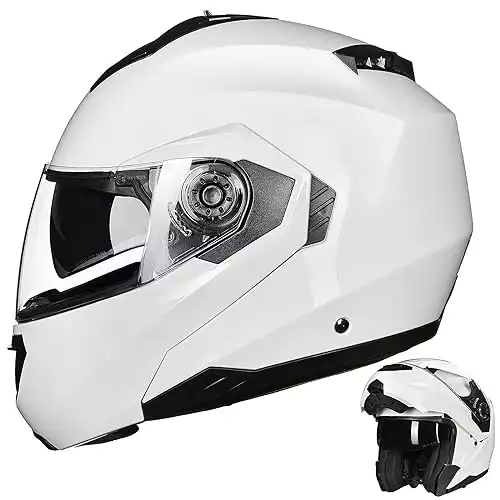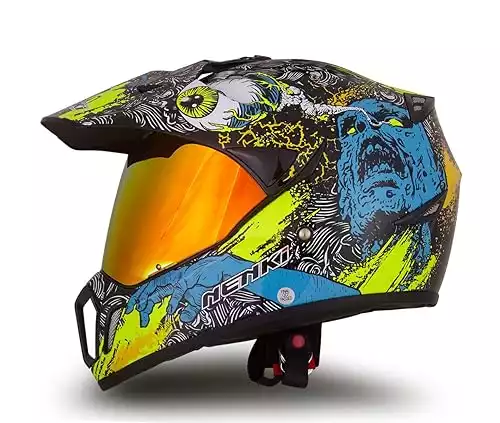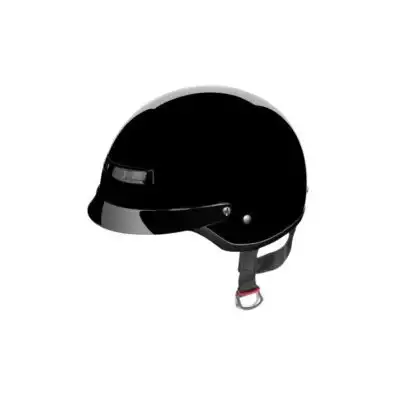Whether you are just starting out and want to try riding before you commit to top-end gear, or you want to keep a backup helmet for when you are cleaning your liners on your main helmet.
Sometimes you just don’t want to overspend on a new helmet.
Whatever the reason for your budget, you will want to make sure that you are buying a motorcycle helmet that is fit for purpose and will protect your head in the event of an accident.
So we have put together a few of the best budget motorcycle helmets followed by a short guide to make sure you get the best lid for the money.
Here are our top motorcycle helmets under $100.
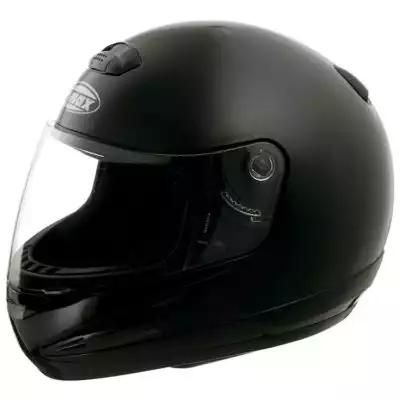 GMax GM38 Helmet
GMax GM38 Helmet
Lightweight and Comfortable, Full-Face Helmet
A comfortable helmet that will fit a large range of riders thanks to the extended size range. It will happily accommodate a Bluetooth communication kit and tinted visors are available.
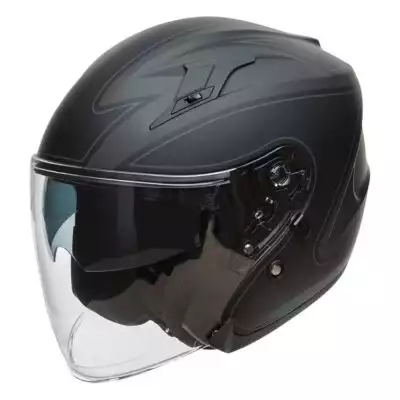 BILT Route Journey Helmet
BILT Route Journey Helmet
Comfortable, Protective, DOT and ECE approved
A bargain open-face with the comfort of full-face features like a visor and sun-shield. It is great for riding in hot weather, and for anyone who may want to fit a comms kit into an open-face lid.
GMax GM38 Helmet
This GMax GM38 helmet is a great full-face option that has proved itself to be lightweight and comfortable.
Weighing in at just 3.4 lbs, the helmet stands out from the pack, as many budget full-face helmets tend to be heavy due to their construction.
To give some perspective, the Arai Defiant-X full-face helmet weighs in at 3.51 lbs, and this is considered lightweight but costs roughly 4 times as much as the GMax.
The helmet is packed with features giving the rider a more premium experience than expected.
A quick-release visor system makes it easy to get the visor off for cleaning, and you can also swap it out if you want to order a tinted visor.
Equipped with a Dual Exhaust Venting System, the vents pull heat and moisture away from the visor area and out of the helmet. The idea is that it will help keep your shield fog-free.
This fog-free system will do the job until it comes to riding in the cold or the rain. You will find your visor still fogs up under these conditions, and this is where the compromise needs to be made.
Mesh lining and trim does the job to keep moisture away and increase ventilation.
There are speaker pockets for easy installation of Bluetooth kits and a chin bar designed to accommodate a microphone without too much trouble.
It incorporates a noise-reducing design with a neck curtain and optimal sealing; however, the helmet is still noisy, particularly at highway speeds.
The helmet is available in sizes XS-4XL; it should fit almost any rider.
The best thing to do is to go for a size smaller if you are between sizes, as it seems that the helmets come up a little large.
The GMax is a comfortable helmet that does the job, with the only real complaints being wind noise at speed and the visor fogging up in cold and wet conditions.
Pros:
- Comfortable
- Feature rich, with tinted visor options and accommodation for comms kits
- Lightweight
- Wide range of sizes and 5 color options
Cons:
- Road and wind noise is quite loud
- Not a great anti-fog system
ILM Modular Motorcycle Helmet
This ILM modular helmet offers a lot of bang for your buck; it is available in 4 colors and 4 sizes.
High-quality ABS outer shell and multi-density EPS foam offer suitable impact protection.
ILM has been producing motorcycle accessories for 10 years and has a reputation for efficient and quick customer service, which is always great if looking for replacement parts like visors etc.
This helmet comes with a retractable internal sun shield which is helpful on a sunny day as there is no need to stop and put your sunglasses on.
Although a little word of warning, the sun visor is operated by a fiddly mechanism, so make sure you practice using it before you set off riding.
Ventilation is adequate with large vents at the chin and top of the helmet. There is also a breath guard, which aims to redirect your breath and keep your visor fog-free.
The large locking mechanism on the chin bar is easy to operate with gloves to flip the front up.
One of the main complaints is that the helmet is quite noisy; however, getting a set of earplugs to wear would solve this problem.
Even the most expensive helmets get complaints about being noisy, and it is quite a subjective issue depending on individual opinions.
Pros:
- Excellent customer service
- Replacement parts available
- Comfortable
Cons:
- Sizing is limited
- Tricky internal sun visor mechanism
- Noisy
BILT Route Journey Helmet
This open-face ¾ shell from BILT is a great helmet for the money.
It comes with a main face shield that flips up and a retractable internal sun-visor, which sets the helmet apart from other open-face options.
The main visor sits flush with the helmet when it is down and equally when flipped up, plus the sun-visor is easy to operate with gloves and feels sturdy.
You have all the freedom of an open-face but have the wind and debris protection with a visor.
The size range goes from XS-2XL, so it will cover a wide range of riders, and the fastening is a Double-D ring which ensures a safe fastening system.
Owners have fitted comms kits with no issues and no reports of discomfort, which is always reassuring.
The plush lining is designed equally for comfort and for ventilation to keep your face nice and cool.
Several owners have tried and tested this helmet to success with eyeglasses, so it could be a good option for those who wear glasses.
The visor is great for this reason, too, as it will protect your glasses from getting the brunt of what the road throws at you.
The only real downside for this BILT lid is that the sun visor could do with being a bit darker to be more efficient.
It is lightweight and comfortable for riding all day, and suitable for hot weather.
The helmet is also DOT and ECE approved.
The upside to this is that ECE testing is more in-depth and has stricter testing procedures than DOT, so you can be sure that the helmet will certainly do its job in terms of protection.
Pros:
- Suitable for those who wear eyeglasses
- Lightweight and comfortable
- Effective sturdy main visor
- ECE approved as well as DOT
Cons:
- Sun Visor needs to be a touch darker
Nenki Dual Sport NK-310 Helmet
I am a big fan of this Nenki helmet, particularly in the Green Skull Graphic, as it really has that Wow factor that I expect from a dual-sport helmet.
Don’t worry; there are two other designs if you want to tone things down a little.
It is super lightweight and comfortable; the liners are also removable, so you can wash them, which is a useful touch.
Two visors come as standard, so you can wear the iridium one in the day and switch back to clear if you’re riding into dusk.
Having read through the reviews, a few people have stated that they have actually had an accident with this helmet, and they suggest the helmet did more than its job to protect them.
This is always great to hear, as often a helmet can look awesome but fall short when it comes to its real purpose.
Ventilation is great with big vents that let the airflow in, but the downside is that wind and road noise is quite high. Again to combat this, I would suggest earplugs.
The only noted letdown is that the comfort liner has come away from the inner liner for several owners, although it does seem that Nenki has been happy to replace cheek pads etc., in these few instances.
Pros:
- 3 Graphics to choose from to suit individual taste
- Iridium and Clear Visor Included
- Protective
Cons:
- Sizing limited with only M-XL available
Z1R Nomad Helmet
As much as I would like to force everybody to wear a full-face helmet, that isn’t how the world works, and so it would be silly to ignore the many half-shell helmets on the market.
The best of the bunch is the Z1R Nomad helmet.
It has an advanced ABS/Polycarbonate construction that, according to Revzilla, exceeds DOT standards.
It sits down on your head rather than giving you that renowned mushroom head look that many open-face helmets do.
There is a removable neck curtain that gives a little extra coverage from the wind or sun glaring on your neck, and it is also ready for a comms kit to be fitted.
The padding and Nylon liner is comfortable, and it does come with forehead vents to increase airflow at the top of your head.
It has a very classic style and won’t look out of place on any big V-twin.
There are also four colors, rather than just black, and the Wine Red, I have to admit, has taken my fancy.
The internal head shape is a round oval, which won’t suit those who need a little more room front-back rather than ear-ear.
Pros:
- Color options
- Advanced protective construction
- Traditional Styling
Cons:
- It is a definite round internal head shape
Buyers Guide
When it comes to buying a helmet, there are a few things that you should consider to make sure you get the right lid for you and your needs.
If you have a strict budget, you need to be even more clear about what you want out of the helmet and understand that there may have to be some compromises.
Related: How much should I spend on a motorcycle helmet?
In this section, I have put together a short guide about the things you need to think about, so you can make sure you buy the right helmet for you.
Protection
How protective the helmet is should be the first thing you consider, and that goes for any budget.
In the US, all helmets have to be DOT approved.
Our list of helmets under $100 only includes DOT-approved helmets.
This means that the manufacturer has sent their helmet off for testing and the US Department of Transport put the helmet through a series of safety tests, and if approved, it has met the required standards to be deemed suitably protective.
You should only ever buy a helmet that has been DOT approved. A helmet that is not DOT approved is illegal and will not have been put through safety tests to see if it is protective.
You may also see helmets that are DOT and ECE approved.
ECE 22.05 and, more recently, ECE 22.06 are standards from Europe that manufacturers need to meet to be eligible for sale; they are applicable in 48 different countries.
However, be warned that for riding in the US, an ECE-approved helmet is still not legal on its own; it also needs to be DOT approved or have both certifications.
Style
Right, so now you have your start point, and you know that all helmets need to be DOT approved and, as such, will meet safety standards.
The next thing to think about is the style of helmet you want.
There are three key styles of helmet: Full-Face, Modular, Open-Face.
Full Face
Full-face helmets offer the most protection as they have chin bars in place to protect the front of your face.
Modular
Modular helmets, if worn in the full-face position, are equally protective. They can be flipped up at gas stations etc., so you can get some air and communicate more easily with other people.
Open Face
Open-face helmets offer the least protection as they have no protective chin bar in place. Some open-face helmets offer a visor that will at least keep any debris from hitting your face, but they should not be relied upon to be as protective in an accident.
Read about our favorite open-face helmets.
Half-shell open face helmets offer even less protection as they tend to line up with your ears, leaving the whole lower half of your face exposed.
This is a personal decision, and everybody has their reasons for which style they decide to shoot for, but at least now you can do so with some knowledge about the level of protection you are getting.
Construction
A helmet’s construction has a big impact on how protective it is.
Several materials are used to construct helmets, including Thermoplastic (ABS, Polycarbonate) and Multi-Composite shells made up of things like Kevlar, Fibreglass, Carbon, etc.
Generally, Thermoplastic shells offer a heavier, harder shell and Multi-Composite are lighter and have a little flex.
Thermoplastic helmets are cheaper to produce; essentially, they are tough plastic that can be heated up and molded into the shape of a helmet.
Multi-composite shells are made up of a tight weave of different materials layered together and formed into the helmet shape.
Thermoplastic helmets in an accident are tough and have no flex; they do a great job of preventing penetration from objects.
Multi-Composite shells react differently to an impact. They will shatter, and the weave will absorb the energy caused by the impact, keeping as much of it away from your head as possible.
Therefore, the key thing to note is that most helmets under $100 will be ABS/Polycarbonate shells.
They will still meet DOT standards and, therefore, still offer a good level of protection. However, it is worth knowing that helmets used in motorcycle racing will always be constructed of Multi-composite shells.
Where this most comes into play is with your riding style.
If you plan on doing a lot of high-speed riding, maybe many highway miles or track days, then the best option would be to up the budget for a helmet using a multi-composite shell.
Sizing and Fit
Another key thing to look out for is making sure you buy the right size, and the fit is correct.
I always say it doesn’t matter if you spend $50 or $500; the most important thing is to make sure your helmet fits properly.
As long as it fits, then the helmet will do its job and protect you properly.
Measuring around the crown of your head will give you a guide about which size to order.
From there, when you try the helmet on, you need to make sure there are no pressure points anywhere. The cheek pads need to be squeezing your cheeks enough so that you couldn’t chew a piece of gum.
I would recommend wearing the helmet for at least 20 minutes around the house (or store) before you go for a ride; that will give you enough time to know whether the helmet will become uncomfortable.
Comfort
Getting the right size helmet will go a long way in determining how comfortable it is for the long haul.
After that, the materials used for the comfort liner and the efficiency of the vents will determine how it feels.
Ideally, you want a moisture-wicking liner that will keep you dry and aid ventilation. Failing this, a mesh material will do a pretty good job of keeping moisture away and allow the air to flow freely.
When it comes to ventilation, you will want to make sure there are vents at the front of the helmet and exhaust vents at the back of the helmet.
Vents at the front will allow cool air in, but if there are no exhaust vents at the back, the air will heat up, and as a result, you will heat up rather than cool down.
Read more about our favorite ventilated helmets.
Extra Features
Helmet technology has come a long way, and there are many features that manufacturers can offer as standard.
The quality of said features will vary budget dependent; however, that is not to say a budget helmet can’t have useful features for riders.
If you plan on fitting a Bluetooth comms kit, then looking for a helmet with speaker pockets will be a good idea to ensure comfort.
Internal sun visors are a brilliant feature; just make sure that the mechanism is sturdy and it is dark enough to serve its purpose.
Conclusion
It is safe to say that there are helmets available for less than $100 that will offer a great level of protection and some pretty cool premium features.
My favorite helmet is the GMax GM38 helmet. It is a lightweight, comfortable protective full-face helmet with 5 color options for riders who are bored of plain black or white like me.
